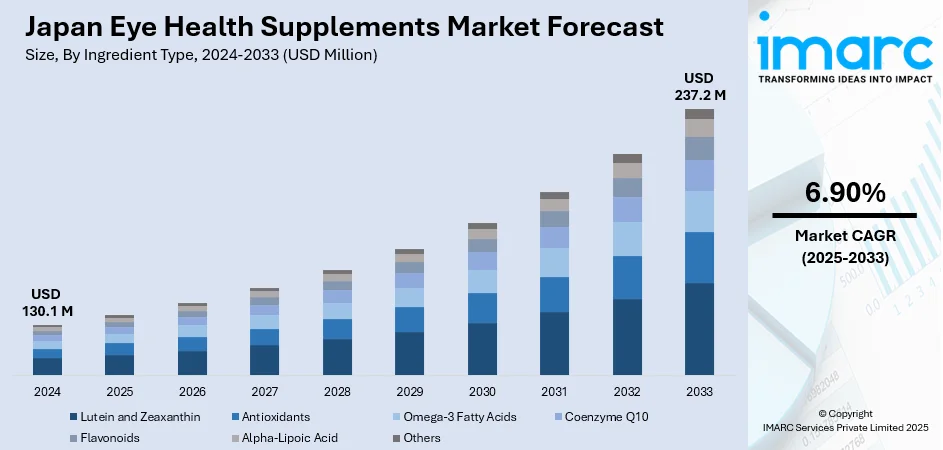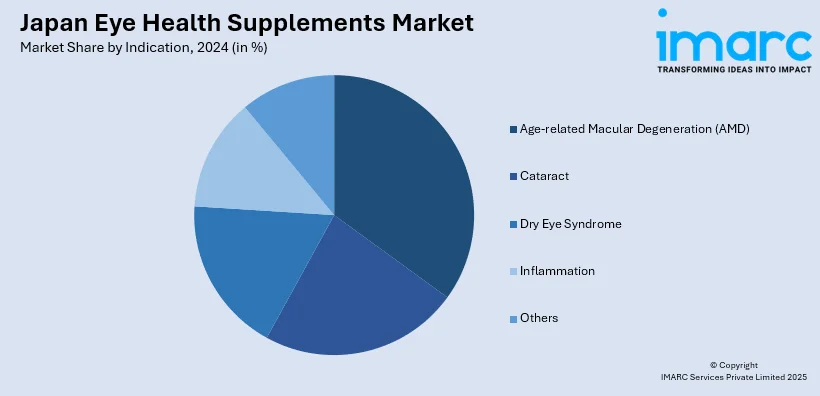
Japan Eye Health Supplements Market Size, Share, Trends and Forecast by Ingredient Type, Indication, Formulation, and Region, 2025-2033
Japan Eye Health Supplements Market Overview:
The Japan eye health supplements market size reached USD 130.1 Million in 2024. Looking forward, IMARC Group expects the market to reach USD 237.2 Million by 2033, exhibiting a growth rate (CAGR) of 6.90% during 2025-2033. The market is driven by an aging population prone to vision issues, increased digital screen usage causing eye strain, heightened health awareness emphasizing preventive care, and a preference for natural ingredients like lutein and zeaxanthin.
|
Report Attribute
|
Key Statistics
|
|---|---|
|
Base Year
|
2024 |
|
Forecast Years
|
2025-2033
|
|
Historical Years
|
2019-2024
|
| Market Size in 2024 | USD 130.1 Million |
| Market Forecast in 2033 | USD 237.2 Million |
| Market Growth Rate 2025-2033 | 6.90% |
Japan Eye Health Supplements Market Trends:
Aging Population and Age-Related Vision Concerns
Japan has one of the world’s oldest populations, and age-related eye conditions such as macular degeneration, glaucoma, and cataracts are increasingly common. According to government data, Japan’s senior population has reached an all-time high of 36.25 million individuals, with nearly one-third of Japanese citizens aged 65 and above. This demographic shift significantly drives the demand for eye health supplements aimed at maintaining or improving vision, fueling the Japan eye health supplements market share. Ingredients like lutein, zeaxanthin, and astaxanthin are popular for their protective effects against oxidative stress and light-induced damage in aging eyes. Older consumers are especially proactive about preventive health, seeking daily supplements that support long-term visual function. Pharmaceutical and nutraceutical companies are responding with age-targeted formulations marketed as non-invasive ways to preserve vision. The aging trend will continue to anchor demand, making this one of the most influential factors in the Japanese market.

Increased Screen Time and Digital Eye Strain
With widespread digital device use in both professional and personal settings, Japanese consumers of all ages face prolonged exposure to screens, leading to symptoms like dry eyes, blurred vision, and eye fatigue. This surge in screen time, intensified by remote work, smartphone dependence, and online learning, has created a new consumer base actively seeking relief through eye health supplements, which is further driving the Japan eye health supplements market growth. Products with ingredients such as bilberry extract, astaxanthin, and omega-3 fatty acids are promoted for their anti-fatigue and circulation-boosting properties. The growing awareness of “digital eye strain” as a lifestyle-related concern is prompting younger consumers, particularly office workers and students, to embrace supplementation as a daily preventative measure.
Rising Preventive Health Awareness
Japanese consumers are increasingly embracing a preventive approach to health and wellness, which includes proactive supplementation to maintain organ function, including vision. Rather than waiting for medical issues to arise, individuals are turning to eye health supplements to preserve eyesight, especially considering modern lifestyle pressures such as artificial lighting and urban pollution. Educational campaigns and eye care awareness promoted by optometrists, pharmacies, and health brands are further creating a positive impact on the Japan eye health supplements market outlook. As consumers become more informed about the importance of ocular nutrition, demand grows for products that offer long-term visual health benefits. This preventive mindset reflects a broader cultural shift in Japan toward managing aging and lifestyle-related health risks proactively.
Japan Eye Health Supplements Market Segmentation:
IMARC Group provides an analysis of the key trends in each segment of the market, along with forecasts at the regional level for 2025-2033. Our report has categorized the market based on ingredient type, indication, and formulation.
Ingredient Type Insights:
- Lutein and Zeaxanthin
- Antioxidants
- Omega-3 Fatty Acids
- Coenzyme Q10
- Flavonoids
- Alpha-Lipoic Acid
- Others
The report has provided a detailed breakup and analysis of the market based on the ingredient type. This includes lutein and zeaxanthin, antioxidants, omega-3 fatty acids, coenzyme Q10, flavonoids, alpha-lipoic acid, and others.
Indication Insights:

- Age-related Macular Degeneration (AMD)
- Cataract
- Dry Eye Syndrome
- Inflammation
- Others
A detailed breakup and analysis of the market based on the indication have also been provided in the report. This includes age-related macular degeneration (AMD), cataract, dry eye syndrome, inflammation, and others.
Formulation Insights:
- Tablets
- Capsules
- Powder
- Others
A detailed breakup and analysis of the market based on the formulation have also been provided in the report. This includes tablets, capsules, powder, and others.
Regional Insights:
- Kanto Region
- Kansai/Kinki Region
- Central/ Chubu Region
- Kyushu-Okinawa Region
- Tohoku Region
- Chugoku Region
- Hokkaido Region
- Shikoku Region
The report has also provided a comprehensive analysis of all the major regional markets, which include the Kanto Region, Kansai/Kinki Region, Central/ Chubu Region, Kyushu-Okinawa Region, Tohoku Region, Chugoku Region, Hokkaido Region, and Shikoku Region.
Competitive Landscape:
The market research report has also provided a comprehensive analysis of the competitive landscape. Competitive analysis such as market structure, key player positioning, top winning strategies, competitive dashboard, and company evaluation quadrant has been covered in the report. Also, detailed profiles of all major companies have been provided.
Japan Eye Health Supplements Market Report Coverage:
| Report Features | Details |
|---|---|
| Base Year of the Analysis | 2024 |
| Historical Period | 2019-2024 |
| Forecast Period | 2025-2033 |
| Units | Million USD |
| Scope of the Report | Exploration of Historical Trends and Market Outlook, Industry Catalysts and Challenges, Segment-Wise Historical and Future Market Assessment:
|
| Ingredient Types Covered | Lutein and Zeaxanthin, Antioxidants, Omega-3 Fatty Acids, Coenzyme Q10, Flavonoids, Alpha-Lipoic Acid, Others |
| Indications Covered | Age-Related Macular Degeneration (AMD), Cataract, Dry Eye Syndrome, Inflammation, Others |
| Formulations Covered | Tablets, Capsules, Powder, Others |
| Regions Covered | Kanto Region, Kansai/Kinki Region, Central/ Chubu Region, Kyushu-Okinawa Region, Tohoku Region, Chugoku Region, Hokkaido Region, Shikoku Region |
| Customization Scope | 10% Free Customization |
| Post-Sale Analyst Support | 10-12 Weeks |
| Delivery Format | PDF and Excel through Email (We can also provide the editable version of the report in PPT/Word format on special request) |
Key Questions Answered in This Report:
- How has the Japan eye health supplements market performed so far and how will it perform in the coming years?
- What is the breakup of the Japan eye health supplements market on the basis of ingredient type?
- What is the breakup of the Japan eye health supplements market on the basis of indication?
- What is the breakup of the Japan eye health supplements market on the basis of formulation?
- What is the breakup of the Japan eye health supplements market on the basis of region?
- What are the various stages in the value chain of the Japan eye health supplements market?
- What are the key driving factors and challenges in the Japan eye health supplements market?
- What is the structure of the Japan eye health supplements market and who are the key players?
- What is the degree of competition in the Japan eye health supplements market?
Key Benefits for Stakeholders:
- IMARC’s industry report offers a comprehensive quantitative analysis of various market segments, historical and current market trends, market forecasts, and dynamics of the Japan eye health supplements market from 2019-2033.
- The research report provides the latest information on the market drivers, challenges, and opportunities in the Japan eye health supplements market.
- Porter's five forces analysis assist stakeholders in assessing the impact of new entrants, competitive rivalry, supplier power, buyer power, and the threat of substitution. It helps stakeholders to analyze the level of competition within the Japan eye health supplements industry and its attractiveness.
- Competitive landscape allows stakeholders to understand their competitive environment and provides an insight into the current positions of key players in the market.
Need more help?
- Speak to our experienced analysts for insights on the current market scenarios.
- Include additional segments and countries to customize the report as per your requirement.
- Gain an unparalleled competitive advantage in your domain by understanding how to utilize the report and positively impacting your operations and revenue.
- For further assistance, please connect with our analysts.
 Request Customization
Request Customization
 Speak to an Analyst
Speak to an Analyst
 Request Brochure
Request Brochure
 Inquire Before Buying
Inquire Before Buying




.webp)




.webp)












